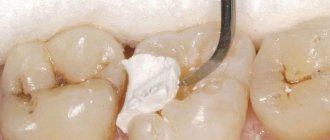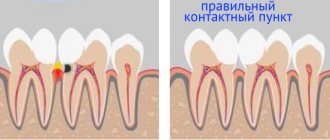Dental inlays
have been used in dental treatment for a long time, but many people still have not even heard of this technology for tooth restoration.
Meanwhile, a dental inlay is better than a large filling or crown. We decided to talk about microprosthetics with dental inlays with maxillofacial surgeon, dentist Tamara Kazbekovna Alakaeva
.
Tamara Kazbekovna, what is a dental inlay?
A dental inlay is a microprosthetic tooth that completely imitates its missing parts (anatomical and functional). The dentist prepares the tooth, takes an impression and sends it to the dental laboratory, after which the dental technician makes an inlay.
Is a dental inlay an alternative to a filling or crown?
Yes, today a dental inlay is a modern alternative to both a filling and a crown.
The inlay is more durable than a regular filling, since the filling contains various micropores, from which caries develops over time (microflora gradually accumulates in microcracks and micropores, causing the development of carious lesions). The inlay fits more tightly to the tooth, so nothing accumulates under it. In addition, the use of a dental inlay provides a more uniform and correct load on the tooth. Unlike fillings, ceramic inlays do not wear out over time and do not change in color or volume. All of the above qualities of dental inlays are their advantages over fillings and crowns.
The only disadvantages of dental inlays include, perhaps, the higher cost and the longer amount of time required for their manufacture. If a regular filling is installed for the patient directly on the day of the appointment, then the manufacture and installation of the inlay requires at least two visits with an interval of at least 7 days, since the dental inlay is made in a dental laboratory.
But the patient must understand that if the tooth is significantly damaged, then the installed filling will not last long. An inlay costs more than a filling, but it lasts about ten years, and with good hygiene – even longer. Many people change their fillings once a year or even every six months. Therefore, the tab is actually cheaper than several fillings that will have to be installed in its place.
How much does it cost to install one tab?
The price of the inlay consists of the cost of the material from which it is made and the work of the doctor and dental technician. In Moscow, a ceramic inlay for one tooth costs on average from 25 to 35 thousand rubles. In addition to ceramic, metal, plastic, composite, and zirconium inlays are installed. The insert can even be made from noble metals (gold).
It turns out that noble metals are still actively used in dental prosthetics?
Not really. Gold inlays
Usually installed on patients who are allergic to metal.
Such patients do not suspect that they have such an allergy and find out about it after the installation of the structure. Therefore, if a person has never had any artificial structure in the oral cavity, he needs to do an allergy test. Ceramic materials
, which are more expensive than metal, are not allergenic. This is their important advantage.
Composite
- this is a material used to make fillings; dental inlays are also made from it; they are about 30% cheaper than ceramic ones.
Made of plastic
Temporary structures are usually made. If the patient’s tooth is fully prepared for the installation of an inlay, and it is impossible to make a temporary filling, he can be given a temporary plastic inlay.
Indications for installation
Ceramic microprostheses cannot always be used instead of a filling. They are installed in the following cases:
- there is damage to the tooth enamel;
- the restored tooth will be used as a support for the prosthesis;
- the degree of its destruction does not exceed 30%.
There are contraindications for installation. Inserts are not fixed to the tooth if:
- There is only one wall left;
- there are carious processes in the oral cavity;
- a milk tooth, because the service life of the inlay exceeds its lifetime;
- more than 60% of the dental tissue is destroyed (in this case it is better to install a crown);
- damaged incisor or canine;
- the patient suffers from nighttime grinding, as in this case the tab will quickly fall out due to heavy load.
There is no point in installing it on wisdom teeth, since they do not participate in the chewing process. It is better not to waste time and money restoring them, but to remove them immediately.
Contraindications for use
If we take into account all the indications and the location of the installation, then the contraindications look like this:
- the natural crown is destroyed by more than half,
- the “nerve” has long been removed from the roots: in this case, the microprosthesis can last much less than the stated period,
- periodontitis, cysts or granulomas are found at the roots: without treatment, the pathology will continue to develop, which will inevitably lead to the need to remove the onlay and treat the periodontium/bone,
- if restoration of incisors or canines is required.
Features and types of tabs
In appearance and properties, a ceramic microprosthesis is practically no different from a real chewing tooth. It is installed on the upper and lower parts of the rows, which are subject to heavy loads.
Products are manufactured using 3D modeling according to individual indications. A dental impression is first made, the data of which the doctor enters into the program. The computer displays the appearance of the future product. It can be corrected and a shade matched to the patient's enamel can be selected.
The design is usually completed within a week. During this time, the patient is given a temporary filling to protect the tooth from damage. There are two types of all-ceramic inlays, differing from each other in material and manufacturing technology:
- Made from pressed ceramic. They are produced using porcelain injection molding under pressure and high temperature. These are aesthetic products, practically indistinguishable from natural teeth.
- High-tech structures made of zirconium dioxide. In appearance they are not inferior to porcelain inlays, and in strength - to metal ones. Their production is fully automated, and there is no human factor. When they are installed, the gap between the dental tissue and the inlay is minimal, which prevents the occurrence of secondary caries.
Not long ago, dentists began using metal-ceramic inlays to restore teeth. They are no different in cost from all-ceramic ones, but they hold up much worse. Their loss occurs because metal and ceramic have different coefficients of thermal expansion. Since the microprosthesis occupies only a small part of the tooth, it quickly falls out.
The process of restoring a tooth with an inlay is quite complicated. The doctor performs it in the following order:
- removes old fillings;
- grinds the surface of the tooth;
- checks, using special means and instruments, how well the damaged tissue has been removed;
- carefully grinds and smoothes the surface for installation so that the inlay fits as tightly as possible;
- takes an impression, which is then transferred to the dental technician;
- After the microprosthesis is manufactured, it is installed using special types of glue.
In the process of tooth processing, many special compounds are used: polishing pastes, etching gels, preparations for hardening glue and others. To ensure that the insert holds as firmly as possible, all products must be used exactly according to the instructions. After installation of a microprosthesis, the patient must follow special oral care rules. This will increase the service life of the ceramic inlay on the tooth.
Treatment technology: how to install inlays
First visit: during the initial examination, the condition of the teeth and oral cavity as a whole is examined. The carious cavity must be removed, if necessary, the nerve of the tooth is cleaned, and the canals are filled. After preparing the cavity, impressions are taken and sent to the dental laboratory. Impressions are taken of at least two teeth – the one being restored and the opposite one. This is necessary so that the restored tooth does not “stick out” and does not interfere with the closure of the jaws. Next, the patient will have a temporary filling installed.
Second visit: the temporary filling is removed and the inlay is tried on. If it fits perfectly and does not cause discomfort to the patient, it is fixed with permanent dental adhesive cement. Its excess is removed and the surface is polished.
Advantages of inlays over fillings
- a more durable option for prosthetics, since a large filling simply cannot withstand the load and falls out - the inlays are fixed stronger and more reliably,
- the risk of developing caries under the inlay is minimized - the microprosthesis fits more tightly, there are no micro-cracks through which bacteria and food debris get under the inlay,
- the tab retains its color and shape even after decades,
- the color is selected as accurately as possible to match the shade of the tooth,
- the inlay can be used to build up and strengthen the tooth for further prosthetics (for example, a crown, bridge or removable denture),
- there is no need to remove the nerve of the tooth if it is not inflamed.
Disadvantages of Tabs
Inlays are a more expensive type of prosthetics compared to conventional tooth filling, since in addition to the dentist-therapist, an orthopedist and a dental technician are also involved. In addition, inlays are made from more expensive materials and it takes much longer to restore a tooth - at least two visits.
Advantages and disadvantages
Ceramic inlays have both advantages and certain disadvantages. The doctor must take them into account when installing. The advantages include:
- high aesthetics of the design, which lasts for a long time;
- ideal compatibility with dentures and crowns;
- low abrasion of tooth enamel;
- the tabs do not darken or change color when exposed to food coloring;
- with their help you can seal even large holes in fabrics;
- the appearance and functions of the tooth are completely restored after installation of the products;
- They are far superior in strength and durability to dental fillings.
Disadvantages include the high cost of products and the duration of their installation. To fix the microprosthesis, you will have to visit the doctor several times.
The price of the structure is several times higher than the cost of the filling, but in the future it pays off. This is explained by the fact that the first one will last for many years, and the second one will have to be changed more often. Another advantage of ceramic inlays is that they reliably protect the tooth from recurrent caries. The same cannot be said about fillings.
When installing a microprosthesis, there is a risk of complications. When preparing a tooth for an inlay, its hard tissues are excised so that the cavity takes on the desired shape. People suffering from hypersensitive teeth experience discomfort.
After installation, over time, secondary caries may occur at the installation site, as a result of which the insert may fall out of the tooth. If this happens, you need to urgently visit the dentist who performed the fixation. If the tab is not lost, then you need to take it with you, and the doctor will put it in its place. Otherwise, the microprosthesis will have to be made anew, which will entail financial costs and loss of time.
What is a filling?
A filling is the restoration of a tooth defect formed after treatment of caries or other tooth damage using filling materials.
In dentistry, there are many filling materials that can replace such defects. Today, the most practical to use are photocomposites (light-curing filling materials). Despite their advantages, fillings also have disadvantages that significantly reduce the lifespan of a tooth:
- shrinkage during light curing,
- chipping of the thin walls of the filling,
- instability to external influences - darken over time, color changes due to exposure to tobacco, coffee and other dyes.
Guided by these shortcomings, the use of fillings in case of large damage is inappropriate. In such situations, the most optimal solution would be to use tabs.
Microprosthesis care
People who have had their teeth restored using an inlay need to carefully care for their oral cavity. You should brush your teeth morning and evening and do this for at least 2 minutes. After each meal, you should use a dental rinse.
Ceramic inlays are a modern and reliable method of microprosthetics. With their help, you can restore even a badly damaged tooth, which allows the row to look aesthetically pleasing. During dental procedures, the patient experiences much less discomfort than when installing a filling, and the ceramic inlay lasts much longer.
Why should you contact TriDental dentistry?
The most painful process during prosthetics is the grinding of bone tissue; the patient feels discomfort, but not pain, since the process is carried out under local anesthesia. First, the dentist cleans the oral cavity and removes plaque and tartar, after which an x-ray is taken, impressions are taken, and an antiseptic treatment is performed.
Many years of experience and equipping the clinic with modern European equipment allowed us to select the most effective and painless treatment methods. Our advantages:
- low prices for ceramic tooth inlays;
- use of high-quality anesthesia;
- individual approach to each patient;
- All services are guaranteed!
To clarify details or make an appointment for the installation of ceramic crowns and inlays, you can always contact our employees for help by phone or through the feedback form on the official website.
Service life and care
The service life of composite microprostheses is several years; ceramic and “dioxide” ones can reach 10 years. Products made by milling on a robotic machine have maximum accuracy and fit to the tooth, so they last longer than usual. First of all, the service life depends on the health of the teeth, since if caries occurs deep in the cavity, it will be necessary to remove the old “onlay”, treat the tooth and install a new one or (more likely) a crown. To extend the life of dental inlays, do not forget about simple hygiene procedures and regular visits to the dentist - during routine preventive examinations, he will be able to detect damage to the denture, since bacteria and microbes can penetrate under it through cracks and cracks.
How does an inlay differ from a filling?
If you compare the functionality and appearance of the insert with native units, there are practically no differences between them. Therefore, microprostheses are actively used for frontal and chewing teeth. It is done personally for each patient. Some believe that the insert is a type of filling. In fact, its parameters are incomparably higher than even modern filling material. This becomes clear if we consider the pros and cons of ceramic inlays. Among the positive qualities it is worth highlighting:
- Increased strength.
- Providing significant strength to unit surfaces.
- High levels of aesthetics. The design is translucent, which accurately imitates a real crown.
- Durability, which is several times longer than the service life of fillings. The inserts retain their original shade for a long time and are resistant to staining.
As for the disadvantages, the system is expensive. This is due to the difficult production of products. True, taking into account all the advantages, the current price is completely justified. It is much lower than that of prostheses. Ceramic inserts are the most successful and aesthetic alternative to both artificial crowns and fillings. They are many times stronger and much more beautiful!











